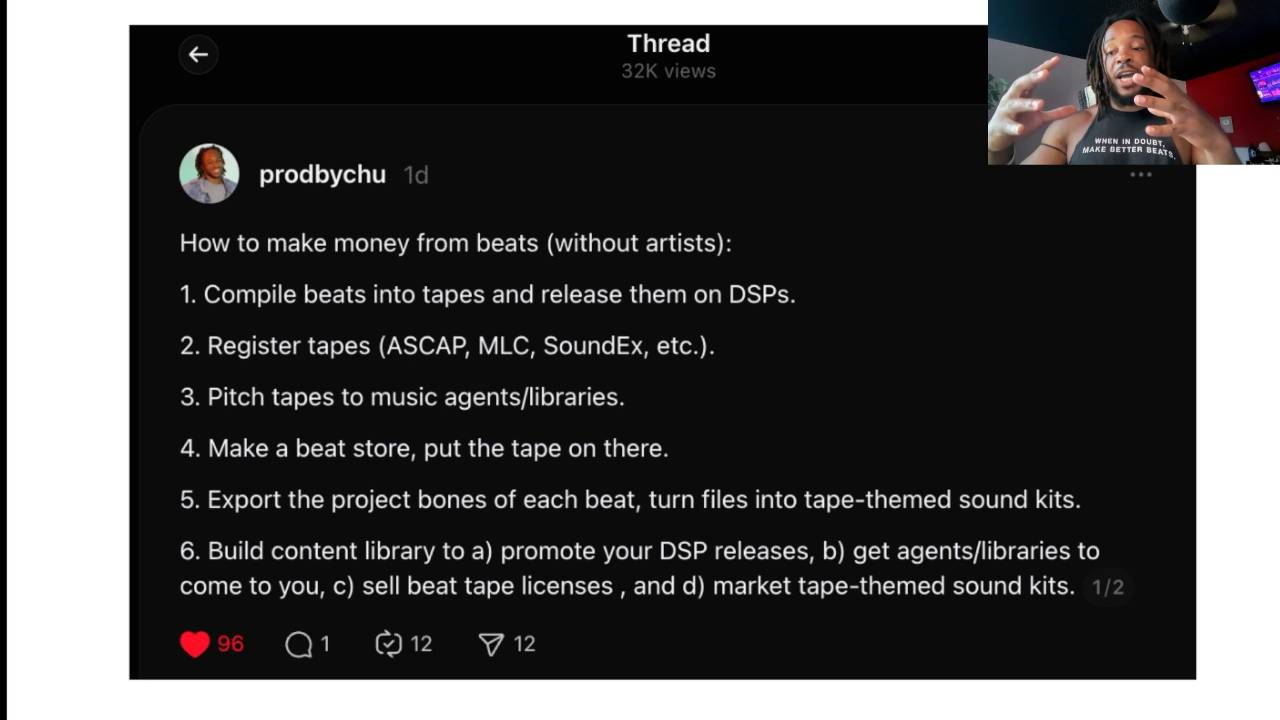Hello beautiful person.
Welcome back to the blog, my name is Chu and today we are going to be going over tips and tricks for creating guitar melodies for Travis Scott…. From scratch of course.
Oh, And I’m holding a beat battle to celebrate reaching 100k subscribers.
It’s ending on Monday, so if you want to participate, hurry to sign up.
But you better come right back here to watch this video!
Alright - Let’s jump into the tutorial.
SOUND SELECTION
Let’s start with sound selection.
This step is essentially the only step that matters.
And that’s true for all music.
You can usually save yourself so much effort by knowing that you have to start with good sounds.
Here’s something I’ve learned from going platinum in South Africa and making hundreds of thousands of dollars from my music.
Good sound = good beat.
Good beat = money.
Money = smile.
So, I normally use Real Guitar when I making a guitar melody if i wanted to go with a paid VST.
And Ample Guitar was really solid as my free option.
But lately, I’ve found myself opening FLEX for basically everything
And guitars are no exception.
All the guitar patches in here are awesome, but my favorite has to be this 60’s Electric Guitar.
Oh, by the way. All of these are free in FL Studio’s FLEX VST which comes stock with all bundles, even the free one.
So I made a 1-4-5 chord progression here.
And I went one step further with making this sound more authentic by strumming my notes with the ALT + S shortcut and then randomizing them with the ALT + R shortcut.
These are two things you can do to almost any melody with any VST to make it sound more like it's being played by hand as opposed to being clicked in by a mouse.
CHORD ARPEGGIO
To me, this is the sauce in making any trap guitar melody - but lowkey this can apply to like... Any genre really because it’s just a regular musical technique.
You can for sure just play the straight chords.
There is nothing wrong with that.
But, your ultimate goal should be to have some bounce or groove somewhere in your harmony. Arpeggio is great for doing this, especially with guitars.
So, arpeggio is when you break apart a chord and create a sequence or pattern from the notes of the broken chord.
Knowing this, let’s see how we can arpeggio our chord here.
I’ve noticed that the ⅓ grid setting is really good for creating rhythmic guitar melodies.
FX
FX are done on the backend once you’ve routed your melody to the mixer.
There are tons of ways to do this with paid VSTs and hella videos going over those methods, so I want to show you some no-cost techniques I use to get the most out of my guitar melodies.
So right off the bat, I want to tell you about one of my favorite FX techniques.
I affectionately refer to it as the ‘ EQ sandwich’.
You’ll see why in a second.
To set this up, I bring in my first EQ, and place it at the top of the chain. This is our first piece of bread in the sandwich.
Keep in mind - the order of these effects is important, as it determines what order of effects the melody will go through.
Switching the sequence may give you a drastically different result.
With this first EQ, I want to do a hard cut on all frequencies under 200 hertz and over 12000 hertz.
This is a pretty standard technique and though you’ll hear different exact numbers and degrees of cut depending on what producer you’re talking to, most will agree that this type of cut is a necessary element for basic mixing.
It is done in order to subtract the highest and lowest frequencies from your melody.
They are almost never needed and serve only to muddy your overall mix.
If you’re interested in more in-depth mixing instruction, or just a general solution to any mixing struggles you may have, I recommend checking out this mixing tutorial.
Alright, so now we need our second EQ - the second piece of bread in our sandwich.
This time we add it to the bottom of our chain so that it is the last thing our input signal encounters before becoming the fully affected output signal that we hear from the mixer.
And we leave it alone for now cause we don’t need it yet.
Now we can add the rest of our effects - the fillings in our sandwich.
First Izotope Vinyl for some wear and tear.
Then, we can toss on some Fruity Chorus using the goated "Fat Clean" preset.
Next, some Fruity Reeverb..
We can use the "Large Hall" setting - be sure to turn the bass knob all the way down so there’s no reverb on your low-end frequencies - you don’t want that.
And then Some Fruity Delay 2 with the widen preset, just for good measure.
This will give the melody even more width and space stacked on top of what it got from the reverb.
Now, here is where the second EQ comes into play.
We want to use it to clean up any really low or really high frequencies that may have been reintroduced to the melody by the plugin effects.
This will keep your melody sounding nice, clean and in control.
CONCLUSION
I added some drums to the finished beat which you can listen to by checking out the video up above!
Again, you can find all of these sounds for free in the 4TEEN Drum Kit.
Thank you so much for watching/reading.
And I greatly appreciate you for spending time with me today.
Peace.
Have a blessed day.
“Stay happy, stay healthy, and always be creating. Just make sure it’s Dope Content Only.”
Get Sound Kits 👇





